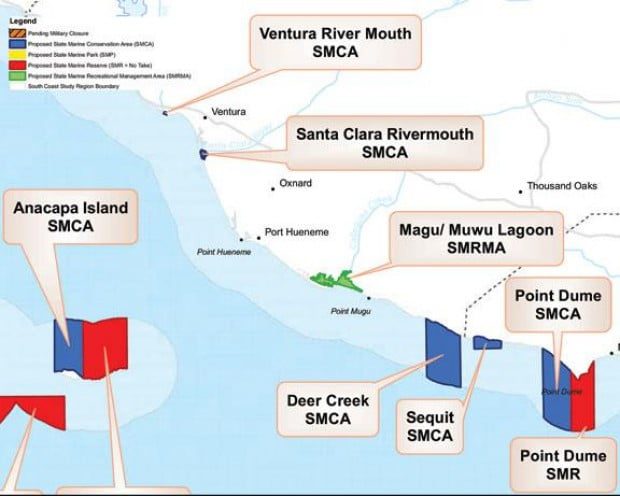
The Malibu City Council votes for one proposal out of three for mapping of marine protected areas, which would affect recreational and commercial activities off the coast off Point Dume, despite support for the other two by residents.
By Olivia Damavandi / Assistant Editor
While Malibu residents remain divided over three different proposals for a Marine Protected Area, the city council at its Monday night meeting voted unanimously in favor of one.
The city council’s vote authorized Mayor Andy Stern to write a letter in support of Proposal No. 1 to the Marine Life Protection Act Blue Ribbon Task Force, which will select one of the proposals at its Oct. 20-22 meeting. The task force will then recommend that proposal to the Department of Fish and Game, which will vote on its final approval Dec. 10. The council will also recommend in the letter that the task force conduct timely evaluations of the selected proposal to ensure its effectiveness.
The MLPA is a state-required program pending adoption to improve and preserve marine ecosystems. The MLPA will implement one of three proposed types of marine protected areas for restricting commercial and recreational activities along the southern coast, including one off Point Dume. The proposals have been hotly debated, as they present different protection levels of Point Dume’s big kelp reef and underwater canyon, which provide nutrients and serve as spawning areas for many species. But fishermen say stringent protection will pose an economic impact on coastal businesses by prohibiting fishing and boat tours, among other activities.
The first proposal, written by a group of conservationists and fishermen, suggests making Point Dume a marine reserve that would encompass the area between Westward Beach and just short of Paradise Cove Pier. The reserve would protect the entire canyon but only some of the big kelp reef, allowing fishing at unprotected parts.
Council members said they chose the first proposal because it is a fair compromise of the other two, and would equally meet concerns of their supporters.
“We need to go back to the goal of MLPA, which was to increase diversity of fish,” Councilmember John Sibert said. “We don’t know enough about marine protected areas, but we do know recently that they actually seem to work.”
Proposal No. 2, written by representatives of the fishing industry, is the most lenient proposal. It suggests making Point Dume a marine conservation area, which would allow limited commercial and recreational fishing. The proposal allows fishing or diving at the big kelp reef or the underwater canyon. The conservation area would span from the northern part of Point Dume to just short of Leo Carrillo State Beach.
The third proposal, written by a group of conservationists and scientists, is the most restrictive. It suggests making Point Dume a marine reserve that would span from Westward Beach to a bit past the Paradise Cove Pier, and completely protects the big kelp reef and underwater canyon.
Nearly 50 residents publicly addressed the council, but not one expressed support for the first proposal. Instead, they delivered emotionally charged testimonies to voice the reasons for their choices. Proposal No. 3 advocates all donned blue T-shirts that read “MPAs Work.”
“I think we need to preserve this area, it means a lot out of everybody,” Alicia Peak, a Malibu resident and supporter of Proposal No. 3, told the council. “We have a choice here. We can preserve it, save the fish and leave it for generations. The whole ecosystem is disappearing. We are depleting this environment. We all love this place so much, let’s take care of it.”
Proposal No. 2 advocates, however, said Point Dume’s ecosystem is thriving and that protection is not necessary.
“A lot of you in the blue shirts haven’t been here [living in Malibu] that long or haven’t been diving in Point Dume,” resident Tim Corliss said at the meeting. “If you dive within current rules there’s no impact. Lately we’ve been diving and the ecosystem is fantastic at Point Dume. Nobody that dives sees any issue with life or the environment out there.”
Corliss, along with several other Proposal No. 2 advocates, also said the adoption of the first or third proposals would create pressure for residents to make Point Dume a public beach.
But Charlotte Stevenson, a marine biologist at Heal the Bay, said in an interview Tuesday that none of the proposals would change the current public access. “If the access point is private, it’s going to stay private,” she said. “The maps only go up to the mean high tide line.”
Stevenson also said that marine protected areas actually benefit the fishing industry in the long run. She referenced nine successful marine reserves that were implemented in the Northern Channel Islands in 2003.
“From a five-year study of those marine reserves, [scientists] found that not only were fish larger and more abundant, but also that there wasn’t the economic disaster the fishing industry predicted. They found that recreational fishing has increased in the Channel Islands since the marine protected area was put in place, and the catch of commercial species has also gone up.”